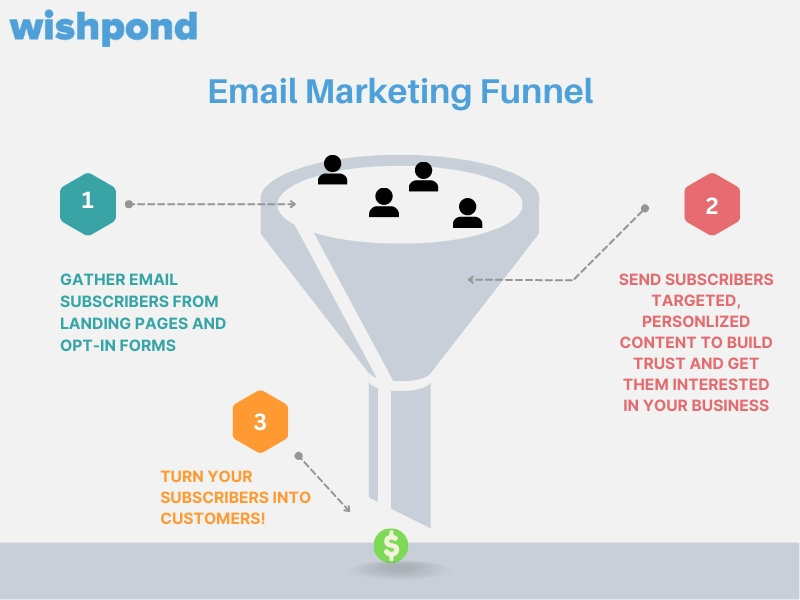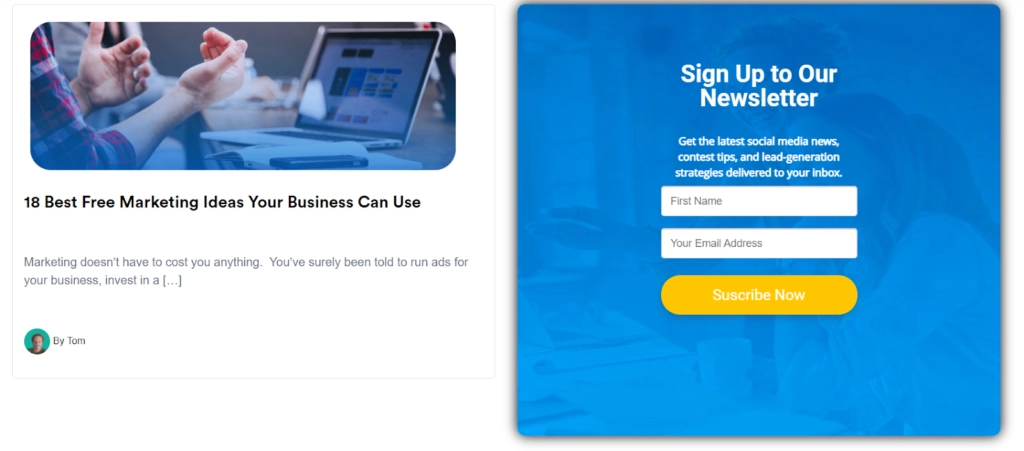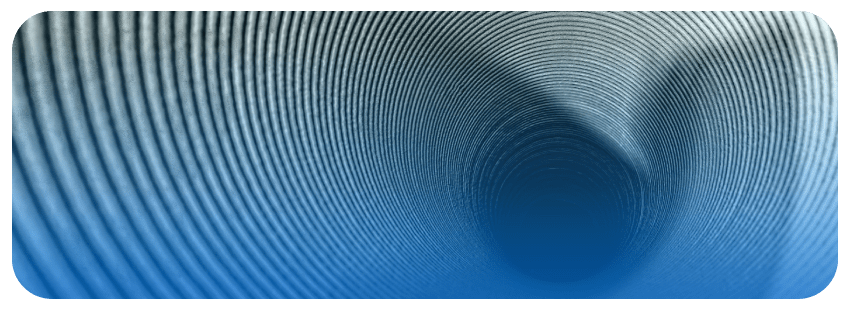Learn what email marketing funnels are, how they work, and how to create them to boost sales.
Email marketing can offer you an ROI of 4400%. Although, you’ll only be able to get these kinds of results if your emails are opened and clicked on by the right people.
Using a well-planned email marketing funnel is the best way to achieve this.
Email marketing funnels provide a smarter framework for building your email marketing strategy. A good funnel will turn subscribers into customers a lot more efficiently.
Not sure where to get started?
This guide will break down everything you need to know about email marketing funnels and how to apply them to your business.
- What is an Email Marketing Funnel?
- Why Use an Email Marketing Funnel?
- Connecting Your Email Marketing Funnel to Each Stage of the Customer Journey
- How to Capture Leads for Your Email Marketing Funnel
- 5 Email Marketing Funnel Tips to Boost Conversions
What is an Email Marketing Funnel?
An email marketing funnel refers to how prospects move through your sales pitch sent via email. This is a traditional marketing funnel model applied to email.
An email marketing funnel aims to understand your prospect’s interests and pain points at each stage of the funnel and send them relevant content that targets this.
The purpose of email marketing funnels is to nurture leads and customers to result in conversions. You achieve this by tailoring each email you send out to match the stage of the buying journey. This makes your email content more relevant and helps you meet your customer where you are.

Why Use an Email Marketing Funnel?
73% of marketers attribute email marketing to increasing their conversion efforts.
Email marketing is a (basically) free marketing channel, and your business owns it. This makes it one of the best marketing tactics to directly reach your target customers and deliver a great marketing ROI.
Email marketing funnels let you send the most relevant content to your leads at the most relevant time. This helps you sell a lot more effectively.
A good email marketing funnel gives you more control over the different steps a customer has with your brand. The customer journey can get messy if you don’t carefully plan this out. It could also prevent you from sending the right messages and value to each prospect.
Get this right, and you’ll be able to convert many more prospects into customers.
Using Automation in Email Marketing Funnels
Another massive benefit of using an email marketing funnel is that you can automate your messaging at the different funnel stages.
Using the right marketing automation platform, you can set up workflows to manage your email marketing funnel. This helps you save time and effort, ensuring the right people are always sent the right messages at the right time.
It also helps you separate your email leads based on their position in the funnel.
As leads interact with your email messages and take specific actions, you can automatically place them in lists based on these actions. This helps you keep leads organized and maintain the right relationships with the right people.
Connecting Your Email Marketing Funnel to Each Stage of the Customer Journey
You must align the funnel to the customer journey to create email marketing funnels. This is a breakdown of a customer’s different stages when interacting with your brand.
What’s important here is that you know why customers make decisions and what drives these decisions.
By aligning the different stages of your email marketing funnel with these customer questions, emotions, and requirements, you’ll get a lot more success out of each stage of the funnel.
To help you plan this out, let’s break down the different buyer journey stages and how you can map these to your email marketing funnels.
Stage 1: Awareness
Awareness, or brand discovery, is the first stage. This is when a potential customer discovers that your brand exists as a solution to their problem.
This starts with a prospective customer searching for a solution to their problem. Your goal here is to present the best possible solution that adds value to the prospect to get them to engage with your email marketing.
This involves getting the prospect to sign up for your mailing list and sending relevant content. Doing so starts their journey with your brand in the best possible way.
You can check out our complete guide on how to grow your email list for some useful tips. We also share some strategies you can use further down in this guide.
As for your email content, you must remember that prospects at this stage of the marketing funnel are not ready to purchase. They’re just finding out more about solutions to their problem, so they’re looking for educational, interesting content that doesn’t involve any serious commitment.
Some of the best types of content to include in this stage of the email marketing funnel are:
- Educational content, like blog posts or YouTube videos
- Free templates or checklists
- Free samples
Or anything else that shows your prospects that you understand their problem and have the solution to help them.
Here’s an example of a top-of-funnel email marketing message you could send:

It’s also important to remember that there is endless free and readily available content online. So, your email marketing funnel should offer something more “exclusive” or valuable than a prospect can get from a Google search. This is why things like ebooks or free templates are so powerful at the awareness stage.
Stage 2: Consideration
The consideration stage of the buyer’s journey is where you must prove to the customer that your brand is the best solution.
The prospect is aware of what you offer, but now they’re comparing your brand to your competitors to determine what direction to take. They also compare your offers against their personal objections, like trust or budget.
At this stage, the prospect understands their problem and the kind of solution they need for it. Now, it’s your chance to show them why your brand is the best possible answer.
Your email content at this stage in the buyer’s journey should address any of the prospect’s objections and highlight the value they could get from your product.
Some of the best type of content to include in your emails at this stage includes:
- Social proof. This is powerful during the consideration stage. Sharing things like reviews, case studies, or testimonials from happy customers goes a long way in building trust.
- Feature benefit comparisons. This is where you mention the features of your product and highlight the benefits each feature offers. Ensure these benefits align with your target customer’s pain points or objections.
- Product videos or demos that show in more detail what your product does and how it can help your prospect.
- Special offers or promotions to keep your target customers engaged.
Ideally, your email automation platform will segment your target audience into different lists. This way, you can send relevant, personalized examples of this content to each list.
Doing so matches your business’s solutions closer to the customer’s pain points, which builds a more compelling case for your product.
Here’s an example of the kind of email you can send at this stage of the funnel:
Stage 3: Conversion
The conversion stage of your email marketing funnel is when you turn subscribers into customers.
You’ve done all the work to attract and engage the subscribers; now it’s the critical time to pull them through the bottom of the funnel as a customer.
When prospects reach the conversion stage, they’re educated, informed, and ready to buy. Well, they just need a nudge to push them into making a sale.
Your email marketing content here should balance out any potential customer’s objections and give them a good reason to complete a purchase. To do this, you’ll want to make your email marketing content short and very action-focused. Including a strong CTA is essential.
Some of the best types of content to include in your emails at this stage of the funnel includes
- Discounts or promotional offers. Making these time-bound helps you add urgency to increase conversions. Again, try to personalize these offers to each prospect.
- Offer to get on a call with the prospect. Sales calls and live product demos can be a great way to close deals and clear up any objections.
- Strong product images and videos.
- You can continue to add reviews and testimonials to build trust.
We’ve got a complete guide to bottom-of-funnel marketing tactics you can use for more insights.
Here’s an example of a conversion-focused email message at the bottom of the funnel:

Stage 4: Retention
The conversion state is where the subscriber becomes a customer. But the customer journey isn’t over just yet.
One of the great things about email marketing is that it lets you stay in touch with your customers, develop long-term relationships, and gain more long-term value from each customer. The aim here is to keep customers coming back for more.
It can cost you five times more to acquire new customers than to sell to your existing ones, so focusing on customer retention can add a lot of value to your business.
Start the retention stage by thanking the customer for their purchase and following up to see how they’re doing.
Then continue to keep them engaged by offering content like:
- Personalized offers
- Useful information to help them get more value from your product
- News about your company or new product releases
- Onboarding options
- Customer loyalty offers
- Requests for feedback
- Personalized discounts or promotions for upgrades or other products
Again, personalization is the key here.
At this stage, you know quite a lot about the customer, so you need to make sure that you send them relevant, personalized content that keeps them engaged with your brand and offers them value. This is why you need a separate list for these customers.
If you had to send your existing customers the same messages you send to top-of-funnel prospects, you won’t achieve your goals or generate engagement from your email campaigns.
Here’s a great example of a retention-focused email marketing message:

How to Capture Leads for Your Email Marketing Funnel
Before you can start building your email marketing funnel, you’ll need to build an email list. Without this, you can’t send email marketing messages to anyone!
While you can build your email list in many ways, there are two main tactics you’ll use to capture leads.
Landing Pages
Landing pages are standalone pages with a single conversion goal. In this case, the goal is to get people to sign up for your mailing list.
You can send people to these landing pages through paid ads, website navigation, organic searches, social media, and more.
The landing page must include a sign-up form and reveal why it would be valuable for the prospect to join your mailing list. This means it should outline the benefits they get from joining your email list.
This could include things like a discount or simply access to exclusive content and tips. In return, you could also offer something of value, like a free ebook or template.
A great strategy is to have multiple landing pages promoting your email marketing list, each aimed at a specific audience segment. This will let you automatically place each lead into a relevant list, so you can start their email marketing journey with your brand on a more personalized note. This will help you increase conversions.
To do this, focus each landing page on a specific pain point that each segment of your target audience might have.

Opt-In Forms
You can also gather email addresses through opt-in forms on your website. These could come in the form of popups or embedded forms on web pages.
Again, you can offer something special to prospects for signing up or simply promote that you have a valuable newsletter. You can also personalize your email marketing funnel with opt-in forms by adding leads to different lists based on which form they converted on.
Ideally, you’ll use a combination of opt-in forms and landing pages to build your mailing list. With a platform like Propel IQ, you get a website builder equipped with these features, all linked to your automated email marketing solution.

5 Email Marketing Funnel Tips to Boost Conversions
Now you know how to create and implement your email marketing funnel.
However, there’s a lot that goes into a successful email marketing funnel. If you want to maximize conversions and get people moving through each stage of your funnel efficiently, here are a few simple tactics you should apply.
1. Segment Your Email List
The best way to increase email engagement and conversions is through personalization. That means sending relevant content to each of your subscribers, personalized to their interests, pain points, and stage in the buying journey,
To do this, you’ll need to segment your mailing list.
Email automation software lets you do this based on your subscriber’s actions. For example, you can have a mailing list based on where prospects signed up. You can then refine these mailing lists based on how they interact with your emails.
You could have mailing lists based on location, gender, customers vs. prospects, etc. The more specific you are with your mailing lists, the more effectively you can personalize your email content.
2. Share High-Quality Content
High-quality content that your audience is interested in is key to generating email engagement and getting your prospects to move down the funnel.
Quality content helps you achieve a couple of different things. It gets prospects more interested in your business, helps to build trust, and positions your business as an industry expert.
High-quality marketing content refers to content that matches your audience’s pain points and speaks to their interests. This should be done with authority and offer useful insights, takeaways, and information that can help solve their problem.
This content can be blog posts, videos, podcasts, social media content, or anything else that offers the user value. By offering free valuable content in your emails, you’re giving subscribers more reason to stay engaged and interested in what you do.
3. Send Your Emails at the Right Frequency
If you want your email marketing funnel to succeed, then you need to make it consistent.
As soon as you stop engaging with your audience, they’ll also stop engaging with you.
The best type of email frequency really just depends on your buyer personas and what they want from your brand. Generally speaking, sending daily emails is too much and can cause your subscribers to lose interest. Sending emails around three times per week should help you to maintain optimum engagement levels.
Just make sure you spend enough time spacing out each stage of the buying journey.
4. Follow the Right Email Marketing Metrics
You won’t know if your email marketing funnels are successful if you don’t keep track of the right email marketing KPIs.
One of the most important factors of a successful email marketing campaign is monitoring the metrics and optimizing your campaigns around them. This can help you generate better engagement each time you send an email, which will help your campaigns become more successful.
You can also A/B test your emails to gain even better insights into your campaign’s performance.
Here’s an in-depth guide to the email marketing metrics you need to know.
5. Use the Right Email Marketing Software
Most importantly, you can’t implement successful email marketing funnels without using the right software.
The best email marketing platform should make setting up and automating your campaigns easy. Of course, this should also offer clear insights into your campaign performance.
Ideally, the platform offers many different customization options and templates to help you create more engaging, interactive emails. You also need to ensure the software works with your other marketing tools, like your lead generation, lead database, website builder, and CRM software.
Summary
Implementing strategic email marketing funnels will help your business save time, better engage prospects, and generate more sales. All this with an outstanding ROI.
If you’re interested in setting up email marketing funnels for your business, you’ll need to use the right email marketing and automation software. With an all-in-one platform like Propel IQ, you get all the marketing tools to cover the entire marketing journey. This includes powerful email automation software, as well as an AI website builder, SMS marketing, referral marketing, sales engagement tools, and more. Get in touch to see how it can work for your business.

